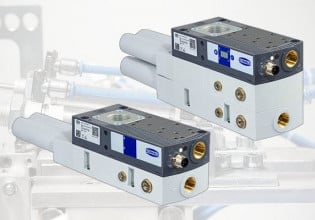Dead Zone Reduction: New Leuze Ultrasonic Sensors
Leuze has launched the 420B and 412B series ultrasonic sensors with both discrete and analog interfaces, presenting a significant advancement for system operators seeking enhanced efficiency.
An ultrasonic sensor (also known sometimes as a sound cone sensor) is a device that emits high-frequency ultrasonic sound waves and detects the echoes that bounce back after hitting an object. It typically consists of a transducer that emits the sound waves and a receiver that captures the echoes. This technology forms the basis of the 420B and 412B series sensors.
Leuze 420B & 412B Sensors Specs
The 420B and 412B sensors stand out for their adaptability and precision. Adjustable sound cone profiles and the ability to vary between roles, such as switching (for the HTU420B and HTU412B) with discrete push/pull outputs, or measuring (DMU420B or DMU412B) sensors with analog outputs, offering versatility across various applications.
The IO-Link interface allows the sound cone to be adjusted to three ranges: "narrow," "medium," or "wide," enabling customization for specific applications. This unique feature ensures that the ultrasonic sensors operate with unmatched precision. Users gain advantages from reduced dead zones and either maintain or improve sensor operating range with the new devices.
What truly sets these sensors apart from optical distance sensors is the ability to detect surfaces that often pose challenges to conventional sensors that rely on light waves. Their sound cone functionality lets them reliably detect glossy, reflective, dark, transparent surfaces or even liquids.

The new Leuze 420B sensors with red plastic housing. Image used courtesy of Leuze
The compact cubic sensors, sized 20.5 x 41.0 x 15.0 mm, and the cylindrical sensors of the HTU412B series, measuring just 50 mm in length by the industry-standard 12 mm diameter, are designed for use in tight spaces. Setting them up is straightforward, with options like the teach button, teach input, or IO-Link for quick parameterization, ensuring efficient operation.
Leuze Sensor Applications
The Leuze sensors are categorized to help customers pick the correct sensors according to their needs. Let's discuss part numbers and their intended uses.
DMU: Precise Distance Measurements
System operators can use the DMU420B and DMU412B ultrasonic distance sensors for accurate measurements. These devices feature analog output (current or voltage), an IO-Link interface, and an adjustable sound cone.

The new Leuze 412B cylindrical (tubular) ultrasonic sensors. Image used courtesy of Leuze
HTU: An Economical Solution for Simple Applications
Leuze offers an economical version of the HTU420B ultrasonic sensors in black housing with a single switching output, suitable for simple detection tasks.
The HTU420B ultrasonic sensors, housed in vibrant red, present a comprehensive solution for demanding detection challenges. They provide two switching outputs, either NPN or PNP, and they come in various operating ranges, including 10-250, 15-500, and 20-1000 mm, while the HTU412B, also with two switching outputs, covers 15-500 mm.
One standout capability is simultaneously monitoring two fill levels or positions, offering enhanced efficiency in industrial settings. As mentioned, the adjustable sound cone adds another layer of adaptability. For instance, the narrow sound cone setting can detect fill levels through small container openings, ensuring accurate measurements even in confined spaces. Conversely, the wide sound cone setting proves invaluable when dealing with expansive areas, such as those containing bulk materials.

Adjustable sound cones can increase versatility and precision for a variety of tasks. Image used courtesy of Leuze
Furthermore, including an interruption filter via the IO-Link interface is a practical feature that significantly enhances operational reliability. By swiftly detecting and mitigating brief measurement fluctuations caused by interfering objects, such as agitators, this filter ensures a smooth production process, minimizing disruptions and optimizing efficiency.





